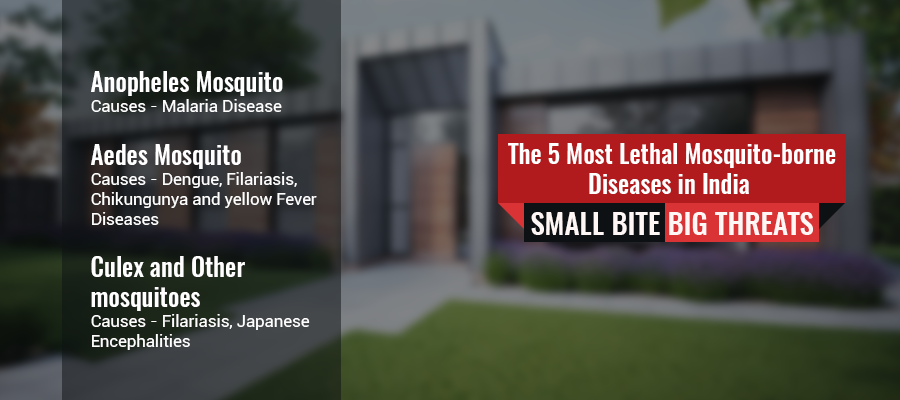
The 5 Most Lethal Mosquito-borne Diseases in India
For several decades, and probably centuries, the Indian subcontinent has been a breeding ground for mosquitoes and mosquito-borne diseases. At present, there are around 400 different species of mosquitoes lingering in India and majority of them are carriers of lethal diseases.
In the last couple of years, the Zika virus has drawn a lot of attention of the masses in India. The mosquito issue in India has urged the government to sanction mosquito control initiatives and increase awareness related to mosquito-borne diseases and how it can be prevented. The dry and humid climate conditions in the coastal regions of India are ideal breeding grounds for mosquitoes.
There are several factors that have boosted the existence of mosquitoes in India. Climate changes, urbanization, the growing population and scarcity of sanitary waste and wastewater disposal facilities have played a vital role in increasing the number of mosquitoes in India.
There are several ways to curb the outbreak and spreading of mosquito-borne diseases. Fumigation drives, mosquito repellent machines, awareness programs, maintaining cleanliness, social planning, and several other methods will significantly decrease the outbreak of mosquito-borne diseases.
As mentioned earlier, there are around 400 different species of mosquitoes in India. As a result, India is always fighting a war against multiple mosquito-borne diseases. Let’s take a closer look at the deadliest mosquito-borne diseases in India.
1. Dengue
The major causes of dengue are the four antigenically distinct viruses that are closely related to each other. The virus can affect a person several times in a lifetime and causes several health issues. The symptoms of dengue start with a high fever. Further, headache, pain in the eyes, pain in the joints and muscles are also the common symptoms of dengue. If not treated at the right time efficiently, dengue can even cause multi-organ failure.
Dengue is a lethal mosquito-borne disease no doubt. However, with the increasing awareness and healthcare alternatives, the number of deaths per 100 patients has decreased.
2. Malaria
The four different species of the genus Plasmodium (P) is the major cause of malaria. The four genus Plasmodium include P. falciparum, P.malariae, P.ovale, and P.vivax. Out of the aforementioned species, P.falciparum is deemed to be the most lethal as it causes damage to the brain and could potentially lead to death.
Nearly a decade ago, P.falciparum infection was the major cause of around 30 percent of malaria cases in India. In the current scenario, the brain strain of the disease has been reported from all parts of India and 60 percent of malaria infections.
3. Chikungunya
When an Aedes aegypti mosquito bites, the chikungunya virus starts spreading. The symptoms include nausea, fever, headache, fatigue, muscle pain, vomiting, and joint pain. Acute infection is likely to last for around a couple of weeks.
In the current scenario, there is no symptomatic treatment that can be used to treat fever and pain. Although chikungunya is not life-threatening, it causes painful deformity in the limbs that could last for a few months.
4. Zika
ika is one of the most dangerous mosquito-borne diseases. There have been several cases of the Zika virus prevalent in regions in which the competent vectors, the Aedes mosquitoes are present. After touching Southeast Asia and South America, there have been cases of Zika virus in India. Between the time span of November 2016 and February 2017, three cases were tested for Zika virus in India. The Ministry of Health and Family Welfare (MoHFW) of the Government of India confirmed the three cases from Ahmedabad City, Gujrat. Further, the World Health Organization (WHO) also confirmed that the Zika virus exists in India. The Zika virus spreads when an infected or diseased Aedes species mosquito bites. The mosquitoes generally bite during daytime or at night. Zika has the potential to spread from a pregnant woman to her fetus. The infection at the time of pregnancy can lead to birth defects. Currently, although research is in full swing for a vaccine, there is no vaccine for the disease at present. There has been a significant increase in the awareness regarding Zika virus to ensure that it does not affect human lives.
5. Lymphatic filariasis
Lymphatic filariasis is commonly known as elephantiasis. The infection causes disability and inflicts heavy damage to the lymphatic system. The lymphatic damage makes the body susceptible to infections.
A thread-like parasitic worm is the major cause of the Lymphatic filariasis. In India, around 99 percent cases of Lymphatic filariasis are caused due to Wuchereria bancrofti. The National Health Policy had set a goal to eliminate Lymphatic filariasis at the end of 2015 by administering mosquito control measures and the drug, diethylcarbamazine.
Mosquito control is not an easy task and could spike several challenges in the process. Understanding the mosquito issue in India, Aero systems have developed AERO, a mosquito-killing machine which is effective and one of the best ways to get rid of mosquitoes from gardens, commercial facilities, and large outdoor spaces. Further, Biogent Mosquito Control, have developed a mosquito-repellent machine called Biogents that is highly effective in smaller spaces. Both the products have been developed keeping in mind the various threats mosquitoes pose to human lives.
There are 400 species of mosquitoes in India today, and our aim is to ensure you and your surroundings is not a breeding ground for these lethal insects.

